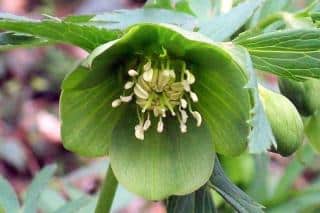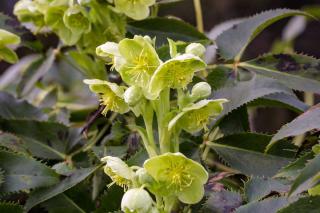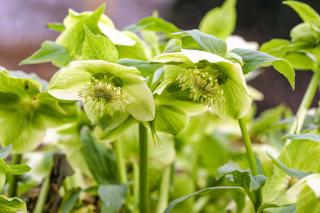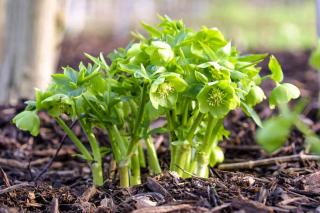

Hellebore flowers are usually white, pink or violet. But there are a lovely green ones, too!
Green hellebore, key facts
Botanical name – Helleborus viridis
Common name – green hellebore
Family – Ranunculaceae
Type – perennial herbaceous flower
Exposure – part shade to shade
Soil – heavy, rocky, neutral, chalky, moist
Height – 8 to 16 inches (20 to 40 cm)
Foliage – not evergreen
Flowering: February to June – Toxicity: very poisonous plant
The green hellebore, Helleborus viridis, is a perennial that is part of the Ranunculaceae family. It owes its name to the acid-green color of its leaves.

Be very careful because the entire plant is poisonous. The green hellebore indeed causes intoxication that is even more severe than that of the stinking hellebore, another wild variety. These two species are easily confused since their flowers are so similar.
In the wild, Helleborus viridis is above all else a forest-dwelling plant. It particularly appreciates partly sunny locations, but can’t cope with full sun at all. The green hellebore grows in heavy, rocky soils, both neutral or chalky, typically very moist in winter. This perfectly hardy hellebore can thrive to altitudes nearing 4800 feet (1500m).
Read also:

The green lenten rose produces wonderful emerald-green flowers. Flowers may be simple or double (Helleborus orientalis ‘Double Green’) depending on the cultivar, some are even dotted with wine-colored dots (Helleborus orientalis ‘Double Green Spotted’).

Stern’s hellebore offers beautiful clusters of jade-green flowers, which it pairs with striking variegated foliage. Each leaf is strongly serrated. This is a hybrid hellebore that is a cross between the Corsican hellebore and Helleborus lividus.
The stinking hellebore is a wild variety with early blooming. Flowering occurs between January and April. Cymes are topped with many small flowers, ½ to 1 inch across (1 to 3 cm), shaped like small bells. They’re pale green with a purple rim.
This botanical hellebore is very rarely cultivated. What is appealing in this one isn’t the flowers, it’s the surprising leafage. The deciduous leaves, ornately serrated and marked, are very ornamental, and they last from spring to fall. The simple flowers release a pleasant elder-berry scent. Star-shaped and vaguely round, they start off acid green and then turn white when mature.

To learn more, read: